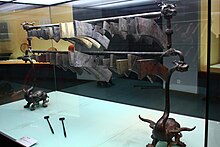Bianqing
Appearance
| Bianqing | |||||||
|---|---|---|---|---|---|---|---|
 Bianqing from the Tomb of Marquis Yi of Zeng | |||||||
| Traditional Chinese | 編磬 | ||||||
| Simplified Chinese | 编磬 | ||||||
| |||||||
| Korean name | |
| Hangul | 편경 |
|---|---|
| Hanja | |
| Revised Romanization | pyeon(-)gyeong |
| McCune–Reischauer | p'yŏn'gyŏng |

The bianqing is an ancient Chinese percussion instrument consisting of a set of L-shaped flat stone chimes known as qing, played melodically. The chimes were hung in a wooden frame and struck with a mallet. Along with the bronze bells called bianzhong, they were an important instrument in China's ritual and court music going back to ancient times.
The instrument was imported to Vietnam (where it is called biên khánh),[1] and Korea (where it is called pyeongyeong). It is still used in Korean court and ritual music.
See also


- Gong chime
- Lithophone
- Bianzhong
- Traditional Chinese musical instruments
- Traditional Korean musical instruments
- Traditional Vietnamese musical instruments
References
- ^ Đại Dương (2010-12-09). "Sắp phục chế thành công 2 bộ nhạc cụ độc đáo đã thất truyền". Retrieved 2016-10-15.
